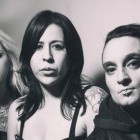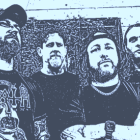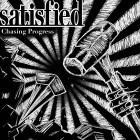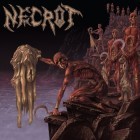
It might not be the first book to cover the musical movement, but NYHC: New York Hardcore 1980 - 1990 is definitely the definitive one. Written by freelance music journalist Tony Rettman, NYHC covers hardcore's first decade, rising from the drug-addled streets of Manhattan's Lower East Side to the suburbs and beyond.
Featuring over 100 original interviews with the musicians, and movers and shakers of the NYHC scene, Rettman's oral history offers an insider's view into the development of the genre's sound and its community. The book is being released by Bazillion Points, a Brooklyn-based publishing house also behind such must-read music geek tomes as Swedish Death Metal and Murder in the Front Row.
A sometime contributor to No Echo, I caught up with Rettman to get the story behind the making of NYHC.
Where were you born and raised?
I was born in a suburb of Trenton, New Jersey called Ewing. I was in equal distance to New York City and Philadelphia, but I was way more into going to New York for shows. Philly was better for record buying.
Did you discover heavy metal first and then work your way to punk and hardcore after that? I ask that because it seems like a common trajectory for people above the age of 40 or so.
No, I was lucky enough to have a brother who was a guiding light into most of my musical existence. He saw Black Flag and the Circle Jerks in the summer of '81 on their first east coast tours. He started taking me to hardcore shows in 1984 when I turned 12.
I remember going away with my parents for our annual vacation to the Jersey Shore in the summer of '85 and coming back to my brother having a roomful of records like Show No Mercy by Slayer, Animosity by Corrosion of Conformity, Dealing With It by D.R.I., the Metal Massacre compilations, and copies of Kick Ass Magazine. I was totally confused! I am still thoroughly convinced that if I never left on that vacation that the infamous crossover of hardcore and metal would have never happened! I was not a big fan of the crossing over of metal and hardcore at first. But in the rearview, you can see how vital it was—especially for New York—to keep the hardcore thing going into the second part of the '80s.
SEE ALSO: 2014 interview with Nick Woj (Cold World, Pegasus, Chelsea Girl).
Who was on the bill at the first hardcore show you ever attended?
The first hardcore show my brother took me to was Black Flag in 1984. This was at the pinnacle of their transformation that made most hardcore fans upset. You know, Henry in shorty-shorts with hair down his back, long instrumental jams, etc. I didn't give a shit, though! I was 12 years old and seeing live music in a tiny club. I was just so happy to be experiencing it. But somewhere in the back of my head, I admit I was a little confused. In my world, the inserts to my brother's records had become my version of comic books. I was fantasizing something like the pictures to be found on the insert of the first Negative Approach 7" or the back cover of the Flex Your Head compilation on Dischord.
A few weeks later, he took me to see J.F.A. and opening up was Death Before Dishonor; a very legendary first wave NYHC band. As soon as I saw them and the people that came out to see them, I was like, "Yes! This is what I'm looking for!" I stood on a chair in the back of the club and just took it all in; the chicken fights, the stage diving, etc. I was blown away.
Later on that summer and fall, I saw Cause for Alarm, Agnostic Front, Kraut, etc. and loved all of them. To experience something like that at such a young age obviously re-wired my brain without me even knowing it. It was a transformation of my thinking and my life that I wasn't aware of at the time. Now, 30 years later, it's pretty obvious that summer totally warped me into the person I am today.
When you were a teenager in the '80s, you co-edited a zine called Common Sense.
Common Sense was done by myself and Tim McMahon, who later went on to front bands like Mouthpiece, Hands Tied, Triple Threat, etc. and currently helps helm the Double Cross website. Tim and I were inspired to do Common Sense by 'zines of the time like Boiling Point and Schism out of New York, Open Your Eyes out of Seattle, and Smorgasbord from Connecticut. We pretty much covered the NYHC and SEHC bands of the time. We interviewed the likes of Youth of Today, Gorilla Biscuits, Sick of it All, No for an Answer, Alone in a Crowd, Chain of Strength, Turning Point, etc. We only did two issues, but I guess due to Tim's longevity in the SEHC scene, the 'zine has taken on some sort of legend with some people.
Looking back at it now, it is pretty damn impressive two kids who couldn't even drive yet busted that thing out. Tim's graphic competency for his age was pretty amazing.
You went on to do a lot of freelance writing for outlets like the Village Voice, Cleveland Scene, and Thrasher. From there, you wrote a book called Why Be Something That You're Not: Detroit Hardcore 1979 - 1985 that the folks at Revelation Records put out.
Writing WBSTYN was definitely a fun experience. Driving out to the Midwest and sitting on the couch of John Brannon while he spieled out the story of Negative Approach was nothing short of mind-blowing. So was sitting in a sushi restaurant in East Lansing, Michigan while Tesco Vee and Steve Miller (The Fix) reeled out tale after gut-busting tale of early '80s Midwest hardcore history.
The content of WBSTYN almost came together on its own in a way, which made doing NYHC: 1980 - 1990 way more difficult. With this book, not only was I covering 10 years rather than the 5 years covered in WBSTYN, but I was dealing with bands as contrasting as Even Worse, Agnostic Front, Nausea, Youth of Today, and Sheer Terror (to name just a few), all operating amongst one another in their own universe. It was intimidating as hell. There were many days and nights where I was at my kitchen table having meltdowns of the Roy Neary variety; all I needed was to be sculpting a mound of mashed potatoes into the form of John Watson. But in the end, I got it done and I can't see where anyone could have an issue with the book at all in regards to the way the subjects are treated or the way the story is laid out. I guess you can just think it out and out sucks in the qualitative sense. And that's fine. All I ask is I'm left in peace.

We first became acquainted after the Detroit book came out. I was running Noisecreep.com back then, and you started doing some writing for the site. I remember you asking me if I thought it would be a good idea to write a book on New York Hardcore. I said it probably wasn't because the topic had been done already, but after reading your book, I'm glad you didn't listen to me!
[Laughs] Yeah, I remember you sending me that e-mail. I'm glad you like the book. I had written a piece for the Village Voice about the A7 Reunion show that happened at the Knitting Factory in December of '08. I was so excited to get this assignment, I went out and interviewed way too many people than I should have for an 800-word piece. I tracked down everyone from Jerry Williams (right before he sadly passed away) to members of first-string NYHC bands like Urban Waste, The Misguided, etc. as well as Jimmy Gestapo of Murphy's Law. After the piece was published, I looked at the piles of tape I had and thought something should be done with all this excess info. This was just when I was getting started on WBSTYN for Revelation, so I figured, after I was done with that, I'd move onto doing some sort of long-form piece on NYHC's early days.
When I was done writing WBSTYN, I went back and listened to the tapes and took notes on how I could wrap up the history of NYHC in a book, but honestly, I felt intimated by the size, history, and legacy of the scene. It was what I grew up on and I wanted to give it the respect it deserved. It was easier to chalk it up as a far-fetched idea and go about my normal life.
Fast forward a few years and Ian at Bazillion Points was prodding me on what my next idea for a book would be. I wrote him an e-mail telling him how I would like to do a NYHC book. Before I knew it, he was like, "Yeah! We'd put that out!" Once I sat at my desk and thought about it, it was a no-brainer; Bazillion Points and a NYHC book was a perfect fit. I made a presentation, chapter outline, etc. specifically for Bazillion Points within a week's time and we signed contracts a month or two later.
I know Ian as a guy who treats every book he releases with great respect. I know he wouldn't cheese it up like some publishers would have and I am eternally grateful to have the opportunity to present it through Bazillion Points.

NYHC is written out in an oral history type of layout, meaning, each person you interviewed for the book tells the story in their own words. I think it's a really effective way of dealing out the tons of information you collected.
I like the oral history format because it's the most unobtrusive way to tell a story. You assemble the quotes like a puzzle and you almost feel like a transmitter beaming out all this info. You're not sticking your two cents in there anywhere. There's no room for revisionist history when you do your stuff in that format.
SEE ALSO: 2014 interview with Michael Gibbons (Leeway).
The book starts out with The Stimulators and concludes with the impact hardcore has had on music. Were there any aspects and/or eras of the NYHC movement that you weren't that well-versed on before writing the book?
I would have liked to delve in more to the late '70s/early '80s punk scene that came up after the likes of the Ramones, Television, etc. either broke up or went mainstream. The bands that start out the book like The Stimulators and The Mad were part of that scene for sure, but then there's bands that were both from New Jersey and New York like The Victims, Shrapnel (pre-Monster Magnet), The Blessed, and The Violators who were doing shows and making records in that void. I remember at some point Arthur Spoiler who plays bass in the awesome Canadian band Omegas was putting together a book about that era. Hopefully he's still plugging away at it because I want to read that shit.
You interviewed a ton of people for the book, but were there any people that you wanted to include that either declined, or you couldn't track down?
There were a few who declined or showed interest but could never nail down a time to talk. Whatever; that's what second editions are for!
In the "Clean Slate" chapter of the book, Walter Schreifels (Quicksand, Gorilla Biscuits) admits that when he first noticed the Hare Krishna consciousness thing coming into the hardcore scene via Shelter, he thought it was a cult type of situation. I'm sure a lot of people felt like that at the time.
Like any kid growing up in the '70s and early '80s, my only knowledge of Hare Krishna came from films like Airplane! or episodes of Three's Company. So, when I found out the Cro-Mags were Hare Krishna in '85, it was a bit perplexing. But then as you sat and thought about it further, the connection between punk rock and Hare Krishna sorta made sense. Think about it; at the same time Krishna Consciousness was a joke to mainstream society, so was punk rock.
If you threw a guy in an orange robe with a shaved head riding on roller skates into the scene of some movie or sitcom, it was an instant laugh. You'd get the same reaction if you threw a crazy looking punk rocker into a scene as well. Nothing got the Middle Americans cracking up like Tim Conway dressed up like he was a devotee or a member of the Viletones. It was two misunderstood movements being judged by their appearances.
Another thing I thought was cool about the Cro-Mags being into Krishna Consciousness was that in some weird way, it made their music more dangerous and subversive to parents and other squares. What's more confounding to some normal ass person than a bunch of hard-as-nails dudes expounding on the body being a mere vehicle for the soul and the pointlessness of material life? I'm sure the Cro-Mags were in the same PMRC crosshairs as Slayer in the mid-'80s because to any Tipper Gore-esque mother, Satan and Prabhupada were one and the same in their sheltered little world.
The funny thing is in the '90s Shelter hitched their wagon to the post-grunge major label buy-up of the underground and ended up opening up for No Doubt! It's kind of funny that in 10 years' time, being a Hare Krishna became harmless and marketable. By the way, that's no diss on Shelter at all. It's just an observation.
Anyone who reads NYHC will be able to see how the hardcore scene started with a more Lower East Side-based crew of people, but by the mid to late '80s, the outer boroughs (Queens, Brooklyn), and suburban Long Island and New Jersey, had pretty much taken over.
The crossover scene of '84 to '85 brought so many people into the scene from the boroughs and 'burbs and all those people kinda chose a path. Some of them went onto the straight edge thing, some went skinhead, etc. and they really helped develop all these splinter scenes within the scene in the late '80s. Some great bands came out of that insurgence of metal guys onto the scene. Altercation, Beyond, etc. The list is huge.
Our mutual friend, Freddy Alva, has been doing an incredible job of documenting the migration of kids into the mid to late '80s NYHC scene right here on the No Echo site. He's delved into the pre-NYHC history of such luminaries as Tom Capone, Kevin Egan, etc. in an obsessively thorough manner that I cannot touch. Honestly! Props to Freddy!
SEE ALSO: The Hispanic Impact on the Early New York Hardcore Scene, by Freddy Alva
What's the biggest misconception people have about the NYHC scene?
The misconceptions of the NYHC scene all revolve around the same misconceptions people have about New York City itself. People think it's a rough city with cold people who don't have time for others. If they took the time to take in both the music and the people who make it, they maybe could learn a little more about why the music and the city is the way it is.
If you were only allowed to play one hardcore song that best represented the style's sound and spirit to someone who had never heard it before, what would it be and why?
From New York or anywhere?
Both.
For anywhere: "Can't Tell No One," by Negative Approach.
For New York?
Shit...
"Power," by Agnostic Front. The song is hard as fuck but it still shows a punk rock spirit. There's a lot of The Germs in that song to me; especially in Roger Miret's vocal delivery. And Stigma's lead on that? Fuck it, man, it's on par with any of Greg Ginn's finest work. It's just this flash of unbridled energy. For now, I'll pick that one. But who knows what it'll be tomorrow.
***
NYHC: New York Hardcore 1980 - 1990 hits bookstores on Dec. 30 via Bazillion Points, and can be pre-ordered on Amazon.




















